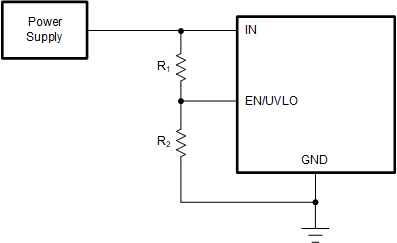SLVSHA1 September 2024 TPS1685
ADVANCE INFORMATION
- 1
- 1 Features
- 2 Applications
- 3 Description
- 4 Device Comparison Table
- 5 Pin Configuration and Functions
- 6 Specifications
-
7 Detailed Description
- 7.1 Overview
- 7.2 Functional Block Diagram
- 7.3
Feature Description
- 7.3.1 Undervoltage Protection
- 7.3.2 Insertion Delay
- 7.3.3 Overvoltage Protection
- 7.3.4 Inrush Current, Overcurrent, and Short-Circuit Protection
- 7.3.5 Analog Load Current Monitor (IMON)
- 7.3.6 Mode Selection (MODE)
- 7.3.7 Parallel Device Synchronization (SWEN)
- 7.3.8 Stacking Multiple eFuses for Unlimited Scalability
- 7.3.9 Analog Junction Temperature Monitor (TEMP)
- 7.3.10 Overtemperature Protection
- 7.3.11 Fault Response and Indication (FLT)
- 7.3.12 Power Good Indication (PG)
- 7.3.13 Output Discharge
- 7.3.14 FET Health Monitoring
- 7.3.15 Single Point Failure Mitigation
- 7.4 Device Functional Modes
- 8 Application and Implementation
- 9 Device and Documentation Support
- 10Revision History
- 11Mechanical, Packaging, and Orderable Information
7.3.1 Undervoltage Protection
The TPS1685x implements Undervoltage Lockout on VDD & VIN in case the applied voltage becomes too low for the system or device to properly operate. The Undervoltage lockout has a default lockout threshold of VUVP internally on VDD and VUVPIN on VIN. Also, the UVLO comparator on the EN/UVLO pin allows the Undervoltage Protection threshold to be externally adjusted to a user defined value. The figure and equation below shows how a resistor divider can be used to set the UVLO set point for a given voltage supply.
 Figure 7-1 Adjustable Undervoltage Protection
Figure 7-1 Adjustable Undervoltage Protection- VEN > VUVLO(R): Device is fully ON.
- VSD(F) < VEN < VUVLO(F): The FET along with most of the controller circuitry is turned OFF, except for some critical bias and digital circuitry. Holding the EN/UVLO pin in this state for > tQOD activates the Output Discharge function.
- VEN < VSD(F): All active circuitry inside the part is turned OFF and it retains no digital state memory. It also resets any latched faults. In this condition, the device quiescent current consumption is minimal.